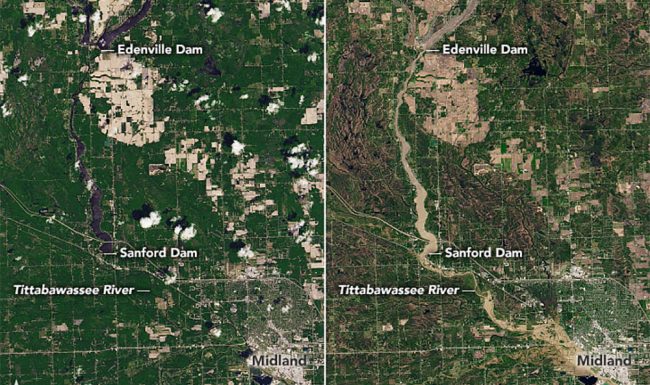Flooding Disaster in Michigan
Photo: These natural-color images show flooding across Midland County as observed by the Operational Land Imager (OLI) on Landsat 8. The pair shows the Tittabawassee River on May 20, 2020 (right), compared to June 3, 2019 (left). NASA Earth Observatory images by Joshua Stevens, using Landsat data from the U.S. Geological Survey.
In late May, the town of Midland, Michigan suffered severe inundation that has been described as a “500-year flooding event”. Although there was no loss of life, the flooding was so extreme and damaging that it dwarfed all other flooding events in living memory. At least 10,000 residents were displaced, and this displacement was complicated by the global pandemic that has swept through the United States. As evacuees arrived at shelters, each person was screened for symptoms of COVID-19, and was then escorted to a spot that was purposely separated from other evacuees by as much space as possible. But as more and more people trickled into the shelters, that spacing became very difficult to maintain. The challenges of coping with any natural disaster is hard enough, but to couple those challenges with an extraordinary public health crisis makes the effort truly Herculean in scope and ramification.
The flooding in Midland has been called ‘a nightmare situation’ that developed after days of heavy rainfall. All this precipitation poured into the lakes at Edenville and Sanford- and the lakes were quickly filled to the brim. Unfortunately, the dam at Edenville had been known as a problem structure for some time; in fact, its license had been revoked by federal inspectors in 2018. The stated reason for the forfeiture of the license was simple: the dam was deemed unlikely to withstand a significant flood. Fast forward two years, and that ‘significant flood’ materialized- at the worst possible moment.
In addition to the hazards posed by the global pandemic, the state of Michigan- as well as much of the rest of the United States- has been embroiled in momentous and widespread civil disturbances and demonstrations. Close to 20% of the US work force is furloughed or otherwise unemployed due to the global COVID-19 pandemic. A large number of people who have been unable to make their rent or mortgage payments are hovering on the brink of homelessness. Emergency services, National Guard, local and federal law enforcement, food banks, shelters, and health care services were already overwhelmed even before the rain began to fall. And then, the rain began to fall- relentlessly.
The run-off from the heavy storms filled Lake Wixom, which was held back by the Edenville Dam. This earthen embankment dam was built in 1924 by a former circus owner named Frank Wixom, who was presumably not an expert engineer. To his credit, Wixom’s earthen dam contained the lake for 94 years, even holding up for a couple of years after it was inspected and deemed unlikely to withstand a major flood. Two years after that inspection, however, Frank Wixom’s old dam finally collapsed.
Much had changed in the years since 1924, including a lot of development along the river as well as the construction of a second dam at Sanford, about ten miles downstream. When the Edenville dam collapsed, a powerful wall of water hurtled towards the next dam, and quickly overwhelmed it. Now two consecutive dams had failed! At this point, the combined volumes of the heavy rainfall, the contents of Wixom Lake, and the contents of Sanford Lake all barreled towards the small city of Midland.
Luckily, there had been engineers monitoring the state of the Edenville dam during the storms. Having failed the inspection, the dam was not to be trusted. At the point that it became likely that the Edenville dam would fail, warnings were issued and the residents of Midland were evacuated. Shortly after the final evacuations were complete, Edenville Dam washed away, with Sanford Dam falling soon after. The town of Midland was soon under nine feet of water.
Now, in the places where Lake Wixom and Lake Sanford used to delight boaters and the homeowners who lived on the banks, gigantic, reeking mud flats stretch to the horizon. Erosion is a huge concern to property owners, as these lakeside structures are now in danger of sliding into the muck. Litigations have already commenced, but restitution and insurance money is a long way off. The community is coming together as much as possible to assist those affected by the flooding, but that group includes almost all of Midland. One thing is certain: the amount of money needed to restore Midland and the two destroyed dams- to say nothing of the loss of hydro power the dams had been producing- is far greater than the amount of investment it would have taken to prevent this disaster.


